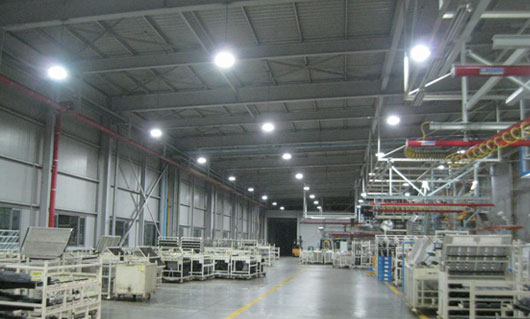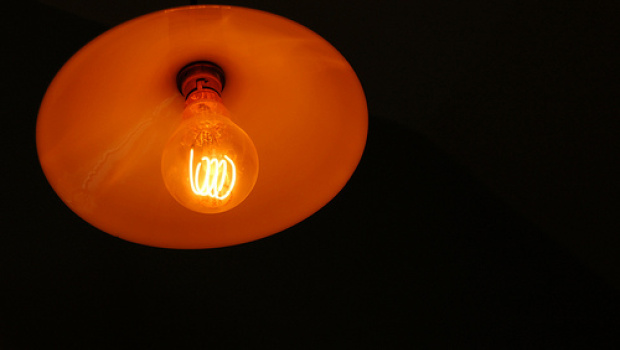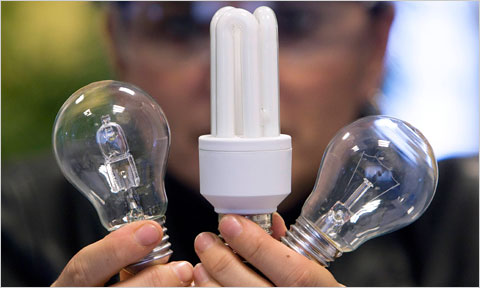
Electronicproducts.com caught up with Gary Raymond, the innovator who created a system of internet-enabled efficiency. Through a series of tests, Mr. Raymond proved that “intelligent efficiency” can successfully lower electric bills, and overall energy consumption. Read on to learn about Mr. Raymond and his undertakings.
Q: Did you have any background in the engineering field before your energy-saving endeavor?
A: Yes — I have a degree in Electrical Engineering from MIT (1974) and an MBA from University of Chicago (1981). I am both an engineer and an entrepreneur, and actively work in these fields. I am the primary owner of Silver Beauty, the real estate development firm which owns the warehouse you are investigating, and am the primary owner of Infopro, a software company.

Q: Can you please elaborate the step-by-step method on how the internet is efficiently connected to electricity system? Please explain exactly what internet lighting “intelligent efficiency” entails?
A: The Digital Lumens fixtures are networked to a device connected to the internet, so that I can remotely monitor energy usage and make program modifications. The alternative would be to travel an hour's time (in non-rush-hour traffic) and some 37 miles to perform this monitoring function or control the system.
Q: Besides lowering energy costs, what inspired you to create this efficient technology? Have you installed similar things in the past to your own home before trialing it on your warehouse?
A: I have installed various LED bulbs and fixtures in my own residence, prior to this warehouse project. I am familiar with the pro's and con's of many lighting technologies – including incandescent, fluorescent (T12, T8, T5, etc), compact-fluorescent, halogen, hybrid halogen/fluorescent (for instant turn-on), metal-halide, LED, low and high-pressure sodium, solar-tube, and fluorescent induction.
Prior to analyzing what might be done in our Warehouse 5, I took a couple of tours of the new Aurora police station, which is a LEED Gold certified “green” building, a 154,000 sq ft facility, completed in late 2009. I spoke to the lead project coordinator about the various design philosophies employed to make the building more efficient.

Source: NY Times
Q: How long did it take you to come up with a working system of “intelligent efficiency?”
A: I took approximately six months to analyze our situation, speak with numerous vendors, become educated on what products were available in the market, and obtain quotations. Once I identified the best solution I could afford, given the current public and private rebates and incentives available, I determined that the Digital Lumens solution would work best for us, and asked that they install a trial of four fixtures in our warehouse.
Q: Do you have to replace all your lights with LEDs before installing the internet lighting system?
A: No — I chose to replace all metal-halide lights in Warehouse 5 with new Digital Lumen fixtures, however fluorescent office lighting remained untouched. I could have chosen to replace any portion of my lighting and could have obtained proportional benefits.
Q: Is it possible to reduce costs if you run the internet-electricity program with regular lights?
A: The electrical cost savings for the fixtures I installed comes primarily from three sources:
· LED technology is more efficient than metal-halide technology. Each of my old fixtures contained a 1000W metal-halide bulb and an 80W ballast. I replaced these one-for-ones with LED fixtures, capable of putting out similar illumination, but only consuming 217W.
· Metal-halide lights have too-long a period of warm-up in order to make use of motion sensors. However LED lighting can switch on and off instantaneously, and can do so even in winter in our unheated warehouses. Fluorescent lighting has trouble switching on and off in cold weather conditions, and fluorescent bulbs diminish in lifetime considerably when switched on and off repeatedly throughout a typical day. LED lights can be switched on and off multi-millions of times with little degradation. We determined, with the help of our tenant, that on average a light would only be switched on for about 25% of the times, with the remaining 75% of time having no fork-lifts or personnel working in the area. On this basis, use of motion sensors could give us an enormous energy savings.
· The LED lights in Digital Lumens fixtures have the ability to be dimmed to output only the amount of light necessary to augment the natural sunlight coming through our sky-lights to achieve the 20 lumens/sq. ft. illumination levels we desired. On a bright sunny day, up to 40% of our light can be supplied, free-of-charge, by the sun. Digital Lumen fixtures have illumination sensors which can detect illumination levels and permit us to “harvest” sunlight in this way. LED dimming capability also helps, because our fixtures are rarely ever 100% on. For security purposes, our tenant usually sets about a 10% illumination level in non-active areas of our warehouse, and perhaps 20% in some non-active aisle areas.
· Digital Lumen software, called “Light-Rules”, is available to monitor and control our fixtures across the internet. This saves us gas and time for travel to and from our warehouse facilities. It also permits our tenant to make changes to programs from their desk-top computers, rather than need to enter the warehouse and visit the office where the computer is located that controls the lighting fixture rules and settings.
Some of these benefits are available with other lighting technologies — The Digital Lumens fixtures just happen to put all of the technology together well and cost-effectively.

Q: What advice can you give to people attempting to install one of these systems in their businesses to reduce costs?
A: My advice would be to hire a local company which is expert in installing, configuring, and training staff for this type of fixture. I hired Green-Light Midwest, a Digital Lumens distributor and installer. They performed the entire job turn-key, even following up to secure the rebates which were promised and helped us obtain the right help to justify and document the EPAct accelerated tax depreciation permitted.
Q: Would you ever start a company that installs web-enabled lighting systems?
A: I have no interest or plans to start a company that performs installations of web-enabled lighting systems. My company is a consumer of such services – not a vendor of such services.
Q: In your opinion, is this technology more efficient than other alternative energy technologies?
A: In my opinion, retrospectively, the solution we chose to implement in April 2012 to replace metal-halide lighting with Digital Lumens fixture LED lighting and internet-based Light-Rules intelligent software, was the best solution available to us at the time. Going forward, I will be considering what to do to improve efficiency in my other warehouse facilities, some of which still have metal-halide lighting, some of which have fluorescent lighting. Each project will be independent, and will consider what technologies and products and energy incentives are available at that time, and each project will be competitively bid, just as all my major projects are bid.
At the present time, I am occupied with re-roofing two of my warehouses, heating another warehouse (not previously heated), and performing a number of other capital improvements. For any project I perform, I always try to think long-term, for a period of time which covers the life-expectancy of whatever capital improvement I install. I would like the lowest total cost (including maintenance, energy, and expendables, net of incentives) and best reliability, over the long-term, for whatever is done. This doesn't always mean the best system. For example, I just replaced three air-conditioning units, which were originally rated at 8 SEER, with higher efficiency units, rated at 16.5 SEER – using about half the original energy. I could have replaced these units with 21 SEER replacements, but when I performed the calculations – including incentives – the difference in energy savings would not have paid back within the expected life of the higher-rated units, even with an assumption that electrical rates could triple during the life of those units. I don't purchase technology for technology's sake; it must perform and pay-back, and I must be convinced that it is the best available option at the time it is installed. On rare occasion, when I know a new technology is being scheduled to roll-out, and am confident that it is worth waiting, I may postpone a non-critical project to get that benefit. But this can all be easily figured out in a cost/benefit analysis, which business people, such as myself, do nearly every day.
Q: Do you think that web-enabled lighting systems pose as a long-term solution for reducing the world’s future electric footprint?
A: I don't have a crystal ball. Like hybrid motor and clean turbo-diesel vehicles, LED and internet-enabled lighting technologies definitely have a place in today's world to help reduce energy costs. New technologies are introduced and older technologies are improved on a continuing basis. Today's solid-state disk drives are larger and faster than “yester” year's spinning disk drives – but the older disk-drive technology also continues to improve and grow in capacity. I look forward to being able to continue to evaluate and review the best and most cost-effective technologies for use in my various businesses and facilities. We live in an exciting world!
Advertisement
Learn more about Electronic Products Magazine





